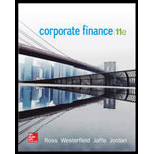
a.
To determine: The ex-rights stock price, the value of a right, and the subscription price.
Rights Offer:
In rights offer, common stock is issued to the existing shareholders. Here, the shareholder issues an option in which a certain number of shares can be bought at a specific price and at a specific duration.
Ex-rights stock price:
The ex-rights stock price is where the right, which are connected with the stock is separated.
a.
Explanation of Solution
Solution:
Given,
The selling price of company stock is $37 per share.
The number of outstanding shares is 1 million.
The firm plans to raise $2.5 million to finance a new project.
Two shares of outstanding stock are entitled to purchase one additional share of the new issue.
Calculation of the ex-rights stock price:
The formula to calculate the ex-rights stock price is,
Substitute $37,000,000 for the current market value, $2,500,000 for proceeds from the offer, 1,000,000 for the number of old shares and 500,000 for the new shares (refer working note) in the above formula.
Hence, The ex-rights stock price is $26.33.
Calculation of the subscription price:
The formula to calculate the subscription price is:
Substitute $2,500,000 for the amount raised and 500,000 for the number of shares offered in the above formula.
Hence, The subscription price is $5.
Calculation of the value of a right:
The formula to calculate the value of a right is:
Substitute $26.33 for the ex-rights price, $5 for the subscription price and 2 for the rights needed to buy a share of stock in the above formula.
Hence, The value of a right is $10.67.
Working note:
Calculation of the new shares:
The new shares offered is 500,000.
Calculation of the current market value:
Hence, the current market value is $37,000,000.
Thus, the ex-rights stock price is $26.33, the subscription price is $5 and the value of a right is $10.67.
b.
To determine: The ex-rights stock price, the value of a right and the subscription price.
b.
Explanation of Solution
Solution:
Given,
The selling price of company stock is $37 per share.
The number of outstanding shares is 1 million.
The firm plans to raise $2.5 million to finance a new project.
Four shares of outstanding stock are entitled to purchase one additional share of the new issue.
Calculation of the ex-rights stock price:
The formula to calculate the ex-rights stock price:
Substitute $37,000,000 for the current market value, $2,500,000 for proceeds from the offer, 1,000,000 for the number of old shares and 250,000 for the new shares (refer working note) in the above formula.
Hence, the ex-rights stock price is $31.6.
Calculation of the subscription price:
The formula to calculate the subscription price:
Substitute $2,500,000 for the amount raised and 250,000 for the number of shares offered in the above formula.
Hence, the subscription price is $10.
Calculation of the value of a right:
The formula to calculate the value of a right:
Substitute $31.60 for the ex-rights price, $10 for the subscription price and 4 for the rights needed to buy a share of stock in the above formula.
Hence, the value of a right is $5.40.
Working note:
Calculation of the new shares:
Hence, the new shares offered is 250,000.
Calculation of the current market value:
Hence, the current market value is $37,000,000.
Thus, the ex-rights stock price is $31.60, the subscription price is $10 and the value of a right is $5.40.
c.
To determine: The change in the wealth of the stockholder from part a. to part b.
c.
Explanation of Solution
Solution:
Given,
The selling price of company stock is $37 per share.
The number of outstanding shares is 1 million.
The firm plans to raise $2.5 million to finance a new project.
The assumption is that the shareholder holds 4 shares and it will implement in both the cases.
Calculation of the current portfolio value:
The formula to calculate the current portfolio value is:
Substitute 4 (assumed) for the number of shares and $37 for the stock price in the above formula.
Hence, the current portfolio value is $148.
Calculation of the new portfolio value in case of part a.
The formula to calculate the new portfolio value is,
Substitute 6 for the number of shares (refer working note) and $26.33 for the ex-rights price, 2 for numebr of rights and $5 for the subscription price in the above formula.
Hence, the new portfolio value is $147.98.
Calculation of the new portfolio value in case of b:
The formula to calculate the new portfolio value:
Substitute 5 for the number of shares (refer working note) and $31.60 for the ex-rights price and $10 for the subscription price and 1 for the number of right in the above formula.
Hence, the new portfolio value is $148.
Working note:
Calculation of the new number of shares in case of part a.:
In this case, the investor will get 2 new shares and so the new number of shares will be 6
Calculation of the new number of shares in case of part b:
In this case, the investor will get 1 new share and so the new number of shares will be 5
Calculation of the difference of the portfolio value:
Hence, the difference in the portfolio value is $0.02.
Thus, the position of the shareholder will increase by $0.02
Want to see more full solutions like this?
Chapter 20 Solutions
Corporate Finance (The Mcgraw-hill/Irwin Series in Finance, Insurance, and Real Estate)
- Which type of bond offers tax advantages? A) Convertible bondsB) Municipal bondsC) Corporate bondsD) Junk bonds help!!arrow_forwardWhich type of bond offers tax advantages? A) Convertible bondsB) Municipal bondsC) Corporate bondsD) Junk bondsexplanation!arrow_forwardWhich type of bond offers tax advantages? A) Convertible bondsB) Municipal bondsC) Corporate bondsD) Junk bondssolutionarrow_forward
- The term 'liquidity' in business refers to:A. The ability to generate profitB. The ease with which an asset can be converted into cashC. The long-term financial stability of a companyD. The amount of debt a company carries need helparrow_forwardNo chatgpt! Which type of bond offers tax advantages? A) Convertible bonds B) Municipal bonds C) Corporate bonds D) Junk bondsarrow_forwardI need correct answer! Which type of bond offers tax advantages? A) Convertible bonds B) Municipal bonds C) Corporate bonds D) Junk bondsarrow_forward
- What is the main purpose of budgeting in a company? A) To eliminate all expensesB) To forecast and control costsC) To increase revenueD) To reduce taxes i need correct answer!!arrow_forward2. A 'competitive advantage' means:A. A company has lower prices than its competitorsB. A company has a unique product or service that gives it an edgeC. A company offers the same product as its competitorsD. A company has the largest market sharearrow_forwardWhich type of bond offers tax advantages? A) Convertible bondsB) Municipal bondsC) Corporate bondsD) Junk bondsneed help!arrow_forward
- Which type of bond offers tax advantages? A) Convertible bondsB) Municipal bondsC) Corporate bondsD) Junk bondsarrow_forwardWhat does "liquidity" refer to in finance? A) The profitability of a companyB) The ease of converting assets to cashC) The value of fixed assetsD) The number of outstanding shares i need answer.arrow_forwardNo chatgpt! What does "liquidity" refer to in finance? A) The profitability of a companyB) The ease of converting assets to cashC) The value of fixed assetsD) The number of outstanding sharesarrow_forward
 EBK CONTEMPORARY FINANCIAL MANAGEMENTFinanceISBN:9781337514835Author:MOYERPublisher:CENGAGE LEARNING - CONSIGNMENT
EBK CONTEMPORARY FINANCIAL MANAGEMENTFinanceISBN:9781337514835Author:MOYERPublisher:CENGAGE LEARNING - CONSIGNMENT Intermediate Financial Management (MindTap Course...FinanceISBN:9781337395083Author:Eugene F. Brigham, Phillip R. DavesPublisher:Cengage Learning
Intermediate Financial Management (MindTap Course...FinanceISBN:9781337395083Author:Eugene F. Brigham, Phillip R. DavesPublisher:Cengage Learning Excel Applications for Accounting PrinciplesAccountingISBN:9781111581565Author:Gaylord N. SmithPublisher:Cengage Learning
Excel Applications for Accounting PrinciplesAccountingISBN:9781111581565Author:Gaylord N. SmithPublisher:Cengage Learning Financial Reporting, Financial Statement Analysis...FinanceISBN:9781285190907Author:James M. Wahlen, Stephen P. Baginski, Mark BradshawPublisher:Cengage Learning
Financial Reporting, Financial Statement Analysis...FinanceISBN:9781285190907Author:James M. Wahlen, Stephen P. Baginski, Mark BradshawPublisher:Cengage Learning Financial AccountingAccountingISBN:9781337272124Author:Carl Warren, James M. Reeve, Jonathan DuchacPublisher:Cengage Learning
Financial AccountingAccountingISBN:9781337272124Author:Carl Warren, James M. Reeve, Jonathan DuchacPublisher:Cengage Learning





